Health consortium provides solutions to bring clean water to remote Alaska villages.
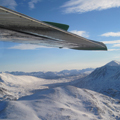
Alaska, the largest of the 50 states, ranks second-to-last in population with its 710,000 residents spread out over more than half-a-million square miles.
Many Alaska Natives live in remote villages without basic infrastructure that most people take for granted. About 25% of the state’s residents do not have access to clean, treated drinking water. The result is poor health and more trips to difficult-to-reach hospitals.
“Some use honey buckets and put their liquid and paper waste in a hole in the ground,” states D. Whittington, the construction manager for the Alaska Native Tribal Health Consortium’s Environmental Health and Engineering Division. “In the summer, the smell gets quite bad. Kids play next to the waste. When an ATV or snow machine comes through there is a lot of splashing. Sanitary conditions are not the best when things thaw out in the summer. It’s a difficult situation. It creates a lot of illness.
“Keep in mind, America has more than 200 years of infrastructure with building things such as highways. Alaska has been a state for just over 50 years. We have 50 years of infrastructure and most of that is within the last 20 years. Going into some of these communities to develop sewer and water systems is like going into Haiti or Nicaragua or places hit with disasters.”
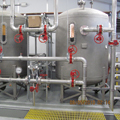
The ANTHC, owned and managed by Alaska Natives through their tribal governments, is fast at work changing those conditions. For the past 15 years, ANTHC’s Environmental Health and Engineering Division has been building health clinics, water treatment plants and sewage treatment facilities for rural Alaskan villages.
“The goal is to improve health and sanitation conditions for native Alaskans,” states Whittington, an Atlanta transplant. “We do that by ensuring that the villages’ water and sewage are properly treated. Some of these people have never had running water in their homes. Our organization builds water and sewer treatment plants out in the wilds of Alaska. The projects are not that large. Most villages have between 50 and 1,000 people. We build fairly small treatment plants.”
The Consortium also installs washaterias, which are facilities in the villages that contain laundries, bathrooms and showers.
“Washing laundry can cost $7 a load in some places,” points out Senior Engineering Project Manager Rebecca Pollis, a Maine native. “Anywhere else in the country, people would be up in arms about that. Here, people are thrilled because they didn’t have to buy a $300 plane ticket to Bethel or a neighboring community to wash clothes.”
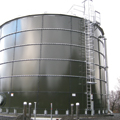
Water behaving badly
Water quality is a major concern in remote Alaska villages. Because of glacial runoff, melting snow and a variety of different soil compositions, Alaska’s water often has a high pH factor. Water acidity is one of the reasons ANTHC uses stainless-steel pipe rather than copper.
“A lot of times, water with a high pH will cause pitting or holes in copper pipe,” Whittington states. “Stainless-steel is a little more forgiving in that respect.”
Using stainless on the projects also is preferable to PVC pipe. “Most villages have a water storage tank on the hillside above the village,” Whittington notes. “PVC pipe can have too high a head pressure in it and end up failing. After we found some PVC failures, we switched to welded steel and stainless pipe.”
Water conditions in the state also can change, resulting in retrofits to the treatment plants. “We’ll build a plant under one set of specifications, then a heavy glacial silt runoff might change the turbidity or the acidity of the water,” Whittington states. “We may end up having to come back and add more equipment or filtering processes.”
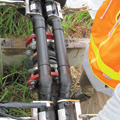
The use of Viega’s ProPress system for stainless to connect pipe at the water and sewage treatment facilities has been a major help. The system, comprised of stainless-steel pipe, valves and fittings, creates a significantly quicker installation time compared to welding or threading.
“The Viega system makes it real easy,” says Whittington, who explains that 1,500 ft. of stainless-steel pipe typically is used on each project along with about 200 different fittings (1/2 in. up to 4 in.). “We come in, shut off some parts of the system, take valves off and then add new pieces of equipment without having to shut down the whole plant. On almost every plant we’ve built, we’ve made changes within the first year because the water changes.”
Creating easier and more efficient construction and maintenance solutions is critical given the Consortium uses local labor to help build and maintain the plants.
“We typically bring in our own plumbing crew, but once somebody else is trained on the process, they can do the plant maintenance,” Whittington states. “When we leave, the locals become the plant’s staff, operating and maintaining the facility themselves. Our Tribal Utility Support Division works with the villages to keep things running smoothly.”
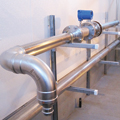
Rough terrain
Building the water treatment plants is the easy part. Getting supplies and manpower to the remote locales can be a different story.
“Most of these villages do not have roads,” Whittington says. “The Delta area in western Alaska is real marshy. The infrastructure between the houses and tribal offices is built on boardwalks. You have to use ATVs and snow machines to get around; otherwise you have to wear chest waders and walk through the muck.”
Some villages rely on barges for delivery of needed materials. Whittington points out a late-summer/early-winter barge headed to Nome last year did not make it due to extreme icing conditions. Flying supplies into Little Diomede Island in northwest Alaska also can be tricky with Russian airspace close by.
“Alaska has nine numbered roads and all are in the extreme eastern-third of the state,” says Whittington, whose division covers an area twice the size of Texas. “There are only three long-distance roads. Once you get west of Anchorage and Fairbanks and north, it’s either barge, airplane, floatplane, snow machine, ATV or dogsleds. It’s a logistical challenge trying to get a million dollars of material out of the lower 48 states and into a village. I’m usually working one to two seasons ahead to get supplies up there.”
Whittington makes sure to specify products that can withstand the harsh Alaskan conditions. The Consortium uses the likes of Grundfos and Armstrong pumps, Toyotomi oil-fired heaters, Weil-McLain and Burnham boilers, Amtrol pressure tanks, Doucette and FlatPlate heat exchangers, and Wessels and Axiom glycol heat exchangers on its projects.
“Our engineers are looking to get tried-and-true products that can take the ruggedness of Alaska and sustain temperatures up to -50° F,” he says. “We look for products we feel will not require a lot of maintenance. It can cost $1,000 to $1,500 to fly in a tech and then $800 to $1,000 more a day to keep someone on the ground. You want the service calls as close to zero as you can. We work to train the local people to help us build the plants and clinics so they are familiar with the parts and pieces. They can take a picture of a leak and we can look at it and diagnose it and walk them through the repairs, if need be.”
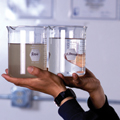
The future
Whittington says five projects are underway and several more are in the design stage. He will soon build a sewage treatment plant in a village plagued by flooding problems.
“In the spring, the river overflows and floods the sewage lagoon,” he states. “The water washes through the village and the waste ends up all over the place. It’s very unsanitary. We’re trying to improve living conditions for the people there.”
Whittington adds the Consortium’s goal is to improve the infrastructure for 322 villages in the state. “We’ve probably done 120 over the last 15 years. It all depends on the funding we get. Hopefully, the economy will get better and we will get more money.”
By installing lower-cost, sustainable and low-maintenance solutions, some of the financial burden is lifted from the Consortium.
“The idea is if we can come in and do a plant cheaper and faster, that gives us extra money for other villages,” he says. “It helps us bring back money into the pool that will help the native population have cleaner and healthier water and upgraded infrastructure for the villages.”
The inroads the Consortium have made in helping improve the life quality of the villagers in those remote locations has been significant. Whittington notes in the last three or four years, gastrointestinal viruses have decreased by more than 50%.
“Our numbers show that when children get clean water from a treated system, respiratory illnesses, skin diseases and intestinal problems drop dramatically,” he says. “It’s a lot cheaper to put in a clinic and get the residents clean water. They stay a lot healthier and are not getting diseases and having to be transferred by Medi-Vac from a remote area to a hospital. By a kid not playing in sewage, respiratory and hepatitis cases come down. Doing what we do is all about helping the kids in the villages. It’s really a neat thing seeing the impact we have on the people.”
Pollis says the finished product is well worth all the planning and logistical challenges that come with projects of this nature.
“I love working with the people in these communities,” she states. “When we complete a project in a village there is such an appreciation for what we’ve given them. Most people don’t wake up and think about where they are going to get water, where they are going to brush their teeth or having to take a pail and dump it in a bin filled with human waste. The joy they express is the biggest reward there is and it’s the reason I keep doing what I do.”
Paying the price
Because of the remoteness, the cost of living in some Alaska villages is quite high. ANTHC’s D. Whittington and Rebecca Pollis have observed the following:
- $6.75 for a gallon of unleaded gas in Nome;
- $7 to $9 for a gallon of heating fuel;
- $11 for a gallon of milk;
- $22.50 for a 1-lb. can of coffee; and
- $72 for a 6-oz. steak in a local village store.
Whittington also tells the story of two of his workers paying $200 for two cases of bottled water. Whittington later shipped the crew 10 cases. The water cost $40 at a local Costco (10 cases at $4 each). The total bill, including shipping came to $800. The $200 water bill now seems like a bargain.